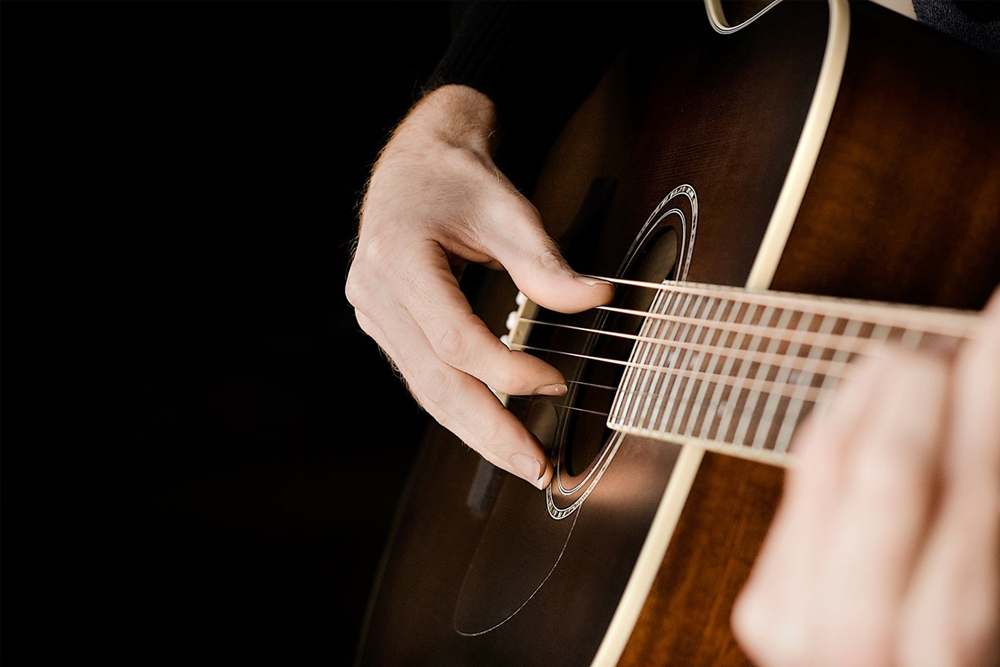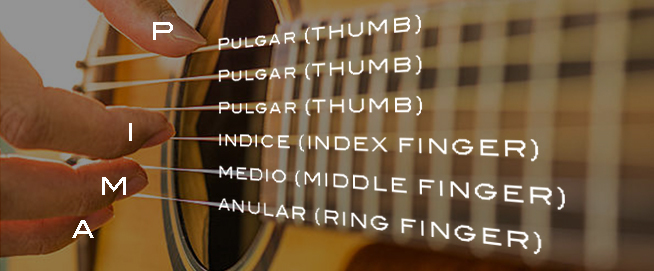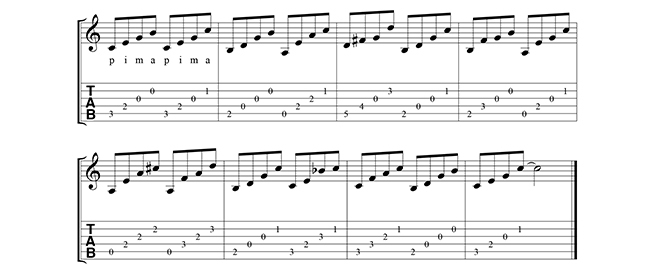
If you haven’t already read our article ‘Are There Different Types of Fingerstyle Guitar?’, I recommend reading it first to understand the subject better before moving on.
Yes, a beginner guitarist can start his or her guitar learning journey with fingerstyle. It’s not the easiest path, but it is definitely doable. In fact, you’ll be choosing the same learning path as a classical guitar student, whose primary skill is built around fingerpicking.
The only difference between you and a classical guitar student would be the type of music you practice with and some variations in your picking techniques (including strumming). But as far as training is involved, they are very identical.
In this article we’ll be looking at:
-
what is the best way to learn fingerstyle guitar?
-
do you need to learn chords when fingerpicking?
-
are there exercises for fingerpicking practice?
-
should you learn fingerstyle or strumming first?
-
which guitar is best for fingerstyle?
What is the best way to learn fingerstyle guitar?
The best way to learn fingerstyle guitar is to first accustom yourself to the P.I.M.A. fingerpicking technique.
P.I.M.A. originated from the classical guitar with each letter in Spanish representing, Pulgar (thumb), Indice (index finger), Medio (middle finger), and Anular (ring finger).
During play, the Pulgar (thumb) of your fingerpicking hand (your right hand if your right handed) will be playing down-strokes on the bass strings e, A, and D, your Indice (index finger) on the G string, Medio (middle finger) on the B string, and Anular (ring finger) on the high E string, all in an up-stroke motion.

In case you’re wondering if the Chico (pinky finger) is ever used for picking, the answer is it rarely is. Though some advanced players do incorporate the pinky into their picking repertoire, the chico (pinky finger) for the most part is being used as an anchor on the guitar for the picking hand as a position reference.
By applying the P.I.M.A. technique, you’ll start learning by assigning roles to each of the thumb, index, middle, and ring fingers to pick a specific string. It is crucial to start building in those muscle memories in the early stages of your learning before moving on to faster, more complex fingerpicking patterns.
Do you need to learn chords when fingerpicking?
The short answer to this question is, no, you do not have to have prior knowledge of guitar chords before you can start learning to fingerpick.
The reason is fingerpicking is a technique focused on your string plucking, hence you can get away with minimal knowledge of guitar chords in the beginning.
For an absolute beginner, if you’re concerned about knowing enough chords to start playing a few songs in fingerstyle, the basic A, C, D, E, F, and G root chords is enough to last you a long way before you really have to start learning new chords.
The important thing is to focus on your fingerpicking technique, building those muscle memories in your fingers so that they can be readily called upon when needed to pick the right strings at the right time.
A word of encouragement if you’re still worried about not knowing any chords before starting to learn to fingerpick, …
Don’t Worry!
You’ll actually learn your chords way faster when you’re learning them at the same time with fingerpicking.
From personal experience, when you’re learning chords and fingerpicking techniques at the same time, you typically spend more time focusing on the fingerpicking aspect of a specific chord, trying to get every finger in place and playing the right strings.
Meanwhile, all that your fretting hand is doing is just pressing down on that one chord. The process actually helps with memory retention for your fretting hand by anchoring the chord you’re holding down with your fingerpicking hand.
In our previous article ‘7 Ways How Learning Music Improves Your Cognitive Skills’ we talked about how stimulations made to our brain can generate new neurons which help with memory retention. In this case, by practicing chords and fingerpicking at the same time, you’re also prolonging the stimulation process, which helps you associate the fingerpicking action with the chord you’re playing.
Are there exercises for fingerpicking practices?
Like all techniques for all musical instruments, there’re sets of practices that can help you improve upon the skill you’re practicing for. And in many a time, not only do these practices help improve your techniques, but they’re also a good way to warm you up to prevent muscle injuries.
In the example below, you’ll see lines and numbers that are called music tablature. In the instance of a guitar, there will be 6 lines representing each of the 6 guitar strings (bass e on the bottom all through to the high E at the top).
The numbers represent the fret positions you need to press down on the fretboard, and you only play the strings that have a number on them.
For example, in the diagram below you’ll see the first set of numbers 3, 2, 0, 0, and 3, 2, 0, 1. In the first 3, 2, 0, 0, it means

For your fretting hand (left hand if you’re a right-handed player):
-
E| X – nothing is pressed nor played as there’re no numbers on the string,
-
A| 3 – you’re pressing down on the bass A string on the 3rd fret,
-
D| 2 – you’re pressing down on the bass D string on the 2nd fret,
-
G| 0 – you do not have to press down on any fret,
-
B| 0 – you do not have to press down on any fret,
-
e| X – nothing is pressed nor played as there’re no numbers on the string,
For your picking hand (right hand if you’re a right-handed player), you’ll be using the P.I.M.A. method:
-
E| X – nothing is pressed nor played as there’re no numbers on the string,
-
A| 3 – pick treble A string with your Anular (ring finger) in an upward motion,
-
D| 2 – pick the treble D string with your Medio (middle finger) in an upward motion,
-
G| 0 – pick the bass G string with your Indice (index finger) in an upward motion,
-
B| 0 – pick the bass B string with your Pulgar (thumb) in a downward motion,
-
e| X – nothing is pressed nor played as there’re no numbers on the string,
In the second part which reads 3, 2, 0, 1, the only difference is you now have to press on to the 1st fret of the bass B string (replacing the previous ‘0’). And now you have a C chord. Your picking hand plays the same P.I.M.A.
Once you have learned the above concept, you can pretty much start practicing with actual songs. The key is to pick a song you like that has relatively manageable chords, just focus on pressing down on the right notes with your fretting hand, and practice your fingerpicking technique using the P.I.M.A. method.
You can also print out the tab sheet and write down P.I.M.A. to remind yourself which strings are being plucked by which finger.
Below's an illustration based on the first bar of the song 'Dust In The Wind' by Kansas. In the example you start off by plucking the A string (3rd fret) with your thumb and the B string (1st fret) with your ring finger at the same time (P/A).
Follow by D string (2nd fret) with your index finger (I), and then the G string (not fretted) with your middle finger, and so on and so forth.

* Click here to watch a video on fingerpicking the song Dust In The Wind.
** You may also download the full tablature of the song here.
Should you learn fingerstyle or strumming first?
This is purely up to you. It depends a lot on the type of music you want to play. For a beginner, if you want to sing along with a song you like while playing your guitar, then obviously strumming would be the easier option.
But if we’re talking about techniques here, then there really isn’t any reason why you should start with one technique over the other.
Many have argued that you need to first develop a rhythmic sense through strumming before you learn to fingerpick. But from personal experience, I actually started learning fingerpicking basic chords first and have found strumming to be more difficult in the beginning.
An objective conclusion to this is that I want you to explore both fingerpicking and strumming and see what feels more (or comes naturally) comfortable to you as a beginner. But if you’re strictly focused on learning to fingerpick, ‘now’ is always a good time to start.
Which guitar is best for fingerstyle?
This can be a tricky question. As a beginner, it’s always tough in the beginning as you’re not used to working your fingers the way you would with learning to play the guitar.
In my opinion, there are 2 main concerns when picking your first guitar, regardless if you’re using it for basic learning or fingerstyle learning.
The first is having a guitar with a neck that is too wide for your hands. This is especially tough for players with smaller hands, hence shorter fingers. The width makes it difficult for a beginner to reach certain notes to form a chord. But of course, as you progress, you’ll come up with your own way to compromise this.
- A basic reference of width would be something like a classical guitar, it’s neck width at the nut is measured typically at about 52mm. This gives the fingers a lot of space to be precise for both fretting and picking.
- A typical acoustic folk guitar would measure somewhere from 43mm to 48mm at the nut. The difference in measurement in most cases is directly related to the type of guitar it is, a dreadnought size would typically have a 43mm neck, while a parlor guitar can have a thicker neck at 45mm.
- An electric guitar typically has the narrowest neck, typically measured at 42mm at the nut, which allows a guitarist to be faster at moving up and down the fretboard while shredding.
The second concern is the ‘action’ of the strings. In our article ‘5 tips to ease your guitar learning journey’ I talked about a common struggle that beginners have with not being able to press down a chord properly due to high actions.
When you’re picking out a guitar as a beginner, be very careful not to buy something that is very low priced, which would often come with a high action on the strings.
Lastly, a quick tip about how to make it easier for you to buy your first guitar. And that is to buy an acoustic folk guitar and change its strings to a set of folk nylon strings.
Let me explain.
Nylon strings are very soft on the fingers and as a beginner, you can avoid a lot of the initial pain in the fingertips. Nylon strings are also a lot easier to hold down on when forming a chord (the same is with electric guitar strings).
But the only problem is, that nylon strings are typically set up on classical guitars and in most cases, you won’t buy a classical guitar unless you’re learning the classical way.
You could of course buy a classical guitar for its soft strings, but the classical guitar has very limited options when it comes to design compared to a folk guitar. Plus it has a wider neck (as mentioned earlier).
So in my case, inspired by the great Jason Mraz (who’s also great at fingerstyle), I swap out the steel strings on my parlor guitar with a set of folk nylon strings, and voila! Best of both worlds. I can now play on a guitar I like with a softer set of strings.
In conclusion, if you’ve set your mind on learning fingerstyle guitar even if you’re a beginner, there is no reason why you shouldn’t. I hope this article has helped clear up some questions you may have on this topic and be sure to check out our other articles in our blog section.
Rock On nn/,




